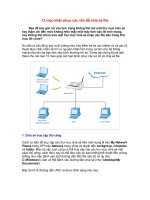Module Linux essentials - Module 12: Network configuration
Bạn đang xem bản rút gọn của tài liệu. Xem và tải ngay bản đầy đủ của tài liệu tại đây (221.65 KB, 22 trang )
Module 12
Network Configuration
This slide deck is for LPI Academy instructors to use for lectures for LPI Academy courses.
©Copyright Network Development Group 2013.
Exam Objective
4.4 Your Computer on the
Objective Summary
Network
–
–
–
Working with the Internet, network, and
routers
Domain Name Service
Network configuration
This slide deck is for LPI Academy instructors to use for lectures for LPI Academy courses.
©Copyright Network Development Group 2013.
Basic Networking
This slide deck is for LPI Academy instructors to use for lectures for LPI Academy courses.
©Copyright Network Development Group 2013.
Basic Network terminology
•
•
•
•
Host - a host is any device that communicates
with another device on a network.
Network - A network is a collection of two or
more hosts (computers) that are able to
communicate with each other.
Internet - A publically accessible network that
connects millions of hosts throughout the world.
Wi-Fi - The term Wi-Fi refers to wireless
networks.
This slide deck is for LPI Academy instructors to use for lectures for LPI Academy courses.
©Copyright Network Development Group 2013.
Basic Network terminology
(cont)
•
•
•
Server/Service - When a host provides a
feature to another host, that feature is called a
service. Example: a web server provides the
service of web pages.
Client - A client is a host that is accessing a
server.
Router - Also called a gateway, a router is a
machine that connects hosts from one network
to another network.
This slide deck is for LPI Academy instructors to use for lectures for LPI Academy courses.
©Copyright Network Development Group 2013.
Basic Network terminology
(cont)
This slide deck is for LPI Academy instructors to use for lectures for LPI Academy courses.
©Copyright Network Development Group 2013.
Networking Features
Terminology
•
•
•
Network packet - Used to send network
communication between hosts.
IP address - An Internet Protocol (IP) address is
a unique number assigned to a hosts on a
network.
Network mask - Also called a netmask or mask,
a network mask is a number system that can be
used to define which IP addresses are
considered to be within a single network.
This slide deck is for LPI Academy instructors to use for lectures for LPI Academy courses.
©Copyright Network Development Group 2013.
Networking Features
Terminology (cont)
•
•
•
Hostname - Each host is provided a humanunderstandable name, called a hostname.
Hostnames are translated into IP addresses
before the network packet is sent on the
network.
DHCP - Hosts can be assigned hostnames, IP
addresses and other network-related information
by a DHCP (Dynamic Host Configuration
Protocol) server.
DNS - A server that provides the service of
translating IP addresses to hostnames.
This slide deck is for LPI Academy instructors to use for lectures for LPI Academy courses.
©Copyright Network Development Group 2013.
Networking Features
Terminology (cont)
•
•
Ethernet - In a wired network environment,
Ethernet is the most common way to physically
connect the hosts into a network.
TCP/IP - The Transmission Control
Protocol/Internet Protocol (TCP/IP) is a fancy
name for a collection of protocols (remember,
protocol = set of rules) that are used to define
how network communication should take place
between hosts.
This slide deck is for LPI Academy instructors to use for lectures for LPI Academy courses.
©Copyright Network Development Group 2013.
IP Addressing
This slide deck is for LPI Academy instructors to use for lectures for LPI Academy courses.
©Copyright Network Development Group 2013.
IP addresses
•
•
•
•
Hosts "address" network packets by using the IP
address of the destination machine.
Two different types of IP addresses: IPv4 and
IPv6.
In an IPv4 address, a total of four “8-bit” (8-bit =
numbers from 0 to 25) numbers are used to
define the address (example: 192.168.10.120).
In an IPv6 network the addresses are much
larger, 128-bit addresses (example:
2001:0db8:85a3:0042:1000:8a2e:0370:7334)
This slide deck is for LPI Academy instructors to use for lectures for LPI Academy courses.
©Copyright Network Development Group 2013.
Configuring the Network
This slide deck is for LPI Academy instructors to use for lectures for LPI Academy courses.
©Copyright Network Development Group 2013.
Configuring Network Devices
•
•
•
Two questions to ask:
– Wired or wireless?
– DHCP or static address?
Desktop machines will normally use wired
network while a laptop will use wireless.
Normally a wired machine uses static IP
address, wireless machines typically use DHCP.
This slide deck is for LPI Academy instructors to use for lectures for LPI Academy courses.
©Copyright Network Development Group 2013.
Configuring the Network Using a
GUI
•
Click on System in the menu bar, then
Preferences and then Network Connections.
This slide deck is for LPI Academy instructors to use for lectures for LPI Academy courses.
©Copyright Network Development Group 2013.
Configuring the Network
Using a GUI (cont)
•
To modify this
network device, click
on the device name
and then click the
Edit button.
This slide deck is for LPI Academy instructors to use for lectures for LPI Academy courses.
©Copyright Network Development Group 2013.
Configuring the Network
Using a GUI (cont)
•
If you click on the
IPv4 Settings tab,
you can change key
IPv4 values.
This slide deck is for LPI Academy instructors to use for lectures for LPI Academy courses.
©Copyright Network Development Group 2013.
Configuring the Network
Using a GUI (cont)
•
Click method to
change from Manual
to DHCP
This slide deck is for LPI Academy instructors to use for lectures for LPI Academy courses.
©Copyright Network Development Group 2013.
Configuring the Network
Using Configuration Files
•
Primary interface configuration file:
–
•
IPv4 settings for static host:
–
–
–
•
/etc/sysconfig/network-scripts/ifcfg-eth0
IPADDR (hosts IP address)
GATEWAY (router’s IP address)
DNS1 (DNS server’s IP address)
IPv4 settings for DHCP client host:
–
BOOTPROTO set to “dhcp”
This slide deck is for LPI Academy instructors to use for lectures for LPI Academy courses.
©Copyright Network Development Group 2013.
Configuring the Network Using
Configuration Files (cont)
•
Additional configuration files:
–
–
–
–
/etc/sysconfig/network – NETWORK and
HOSTNAME settings
/etc/resolv.conf – DNS server settings
/etc/hosts – Local hostname to IP address
translation
/etc/nsswitch.conf – Used to modify which
hostname to IP address translation service to use
This slide deck is for LPI Academy instructors to use for lectures for LPI Academy courses.
©Copyright Network Development Group 2013.
Restarting the network
•
After changing a network configuration file, you
either need to reboot the machine or run the
following command as the administrator to
make the changes take affect:
–
service network restart
This slide deck is for LPI Academy instructors to use for lectures for LPI Academy courses.
©Copyright Network Development Group 2013.
Network Utilities
This slide deck is for LPI Academy instructors to use for lectures for LPI Academy courses.
©Copyright Network Development Group 2013.
Network Tools
•
•
•
•
•
•
ifconfig - Displays interface configuration
information.
route - Displays the routing table.
ping - Used to determine if a remote machine
can be contacted via the network.
netstat - Display network statistics.
dig - Displays query results from DNS servers.
ssh - Allows a user to login to a remote
machine.
This slide deck is for LPI Academy instructors to use for lectures for LPI Academy courses.
©Copyright Network Development Group 2013.









